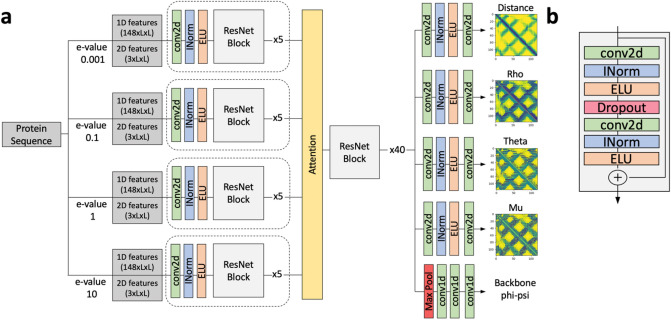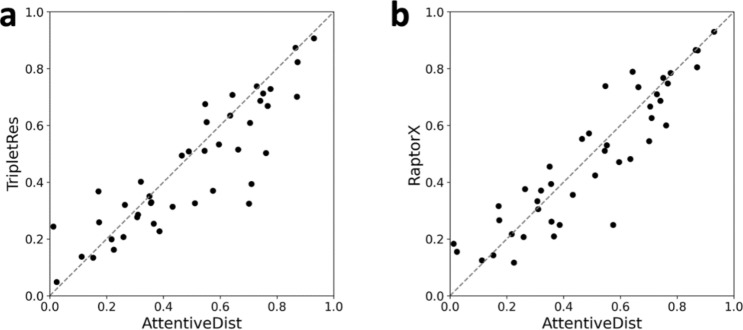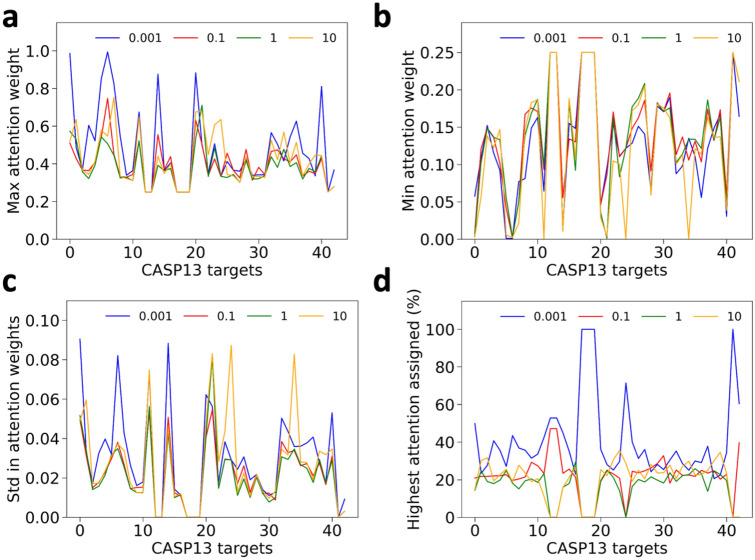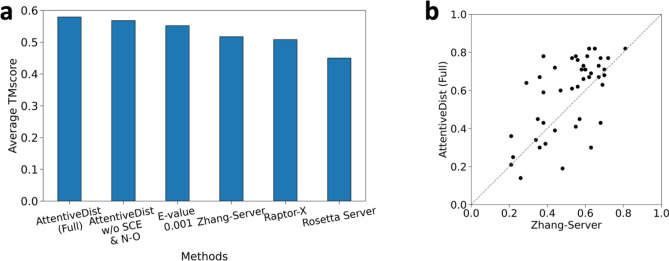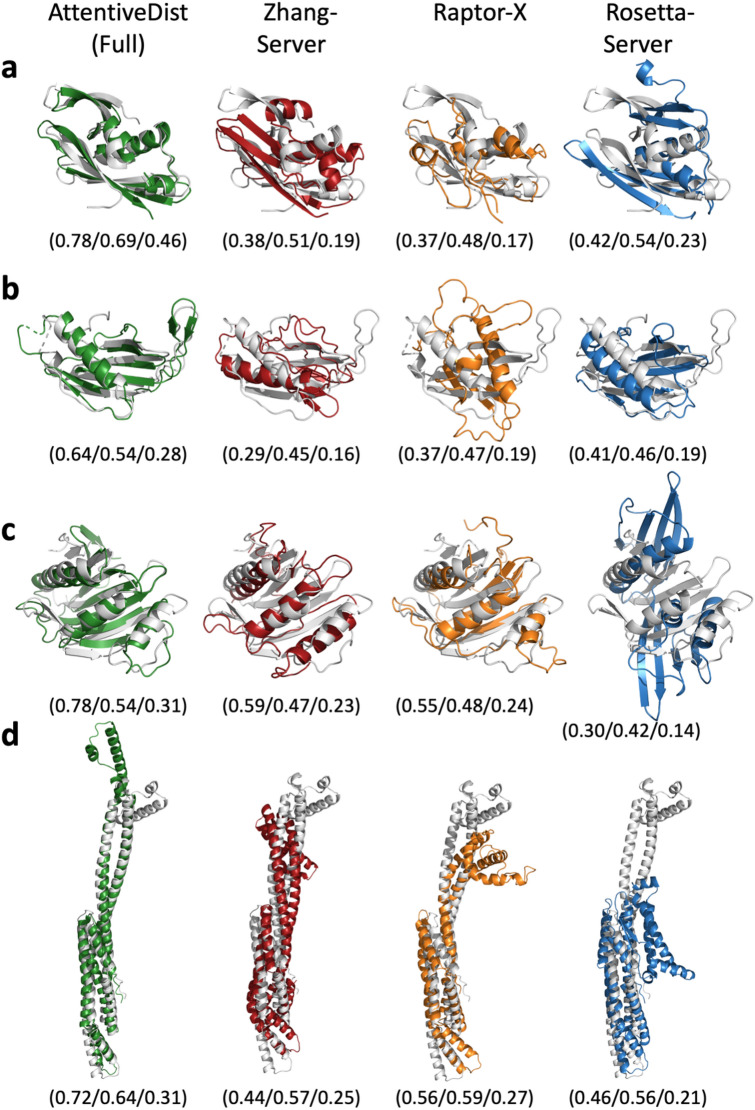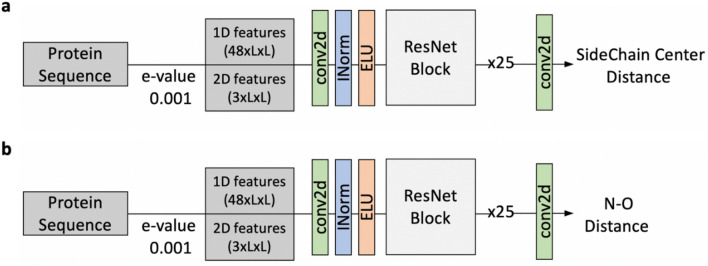Abstract
Protein 3D structure prediction has advanced significantly in recent years due to improving contact prediction accuracy. This improvement has been largely due to deep learning approaches that predict inter-residue contacts and, more recently, distances using multiple sequence alignments (MSAs). In this work we present AttentiveDist, a novel approach that uses different MSAs generated with different E-values in a single model to increase the co-evolutionary information provided to the model. To determine the importance of each MSA’s feature at the inter-residue level, we added an attention layer to the deep neural network. We show that combining four MSAs of different E-value cutoffs improved the model prediction performance as compared to single E-value MSA features. A further improvement was observed when an attention layer was used and even more when additional prediction tasks of bond angle predictions were added. The improvement of distance predictions were successfully transferred to achieve better protein tertiary structure modeling.
Subject terms: Computational biology and bioinformatics, Structural biology
Introduction
Computational protein structure prediction is one of the most important and difficult problems in bioinformatics and structural biology. Understanding protein structure can unlock information about protein function, and can aid in the design and development of artificial proteins and drug molecules1,2. Recently, a significant improvement in protein structure prediction has been observed due to improvements in contact and, more recently, distance map prediction3. The predicted contacts/distances are used to drive computational protein folding, where the 3D atomic protein structure is predicted without the need for template structures4.
The core principle behind modern contact prediction is detecting coevolutionary relationships between residues from multiple sequence alignments (MSAs)5. Previous contact map prediction approaches used direct coupling analysis to identify these relationships. These methods include CCMPred6, PSICOV7, Gremlin8, EV fold9, and plmDCA10. The next wave of methods, which represents the current state of the art, uses deep learning to predict contacts/distances. Deep learning-based methods have improved contact prediction significantly. This is evident from the recent community-wide assessment for structure prediction, CASP133 (Critical Assessment of Structure Prediction), where top-performing methods in structure prediction including AlphaFold11 and methods in contact prediction including RaptorX12, TripletRes13, and ZHOU Contact14 are all deep learning-based. Raptor-X and Alphafold also showed that predicting distance distributions instead of binary contacts can further improve the performance. However, the current approaches are still not accurate enough to consistently achieve structure modeling with high GDT-TS structure evaluation scores3. Thus, further improvement is still needed.
One of the keys for accurate distance/contact prediction is the quality of MSAs15,16. Recent works have used a conservative E-value cutoff to generate MSAs because using a large E-value cutoff can lead to noisier and sometimes incorrect co-evolution information in the MSA. On the other hand, a larger E-value cutoff can yield an MSA containing more sequences, which may provide useful information particularly when a query protein does not have many close homologs. The difficulty is that the appropriate level of sequence similarity depends on the protein family17,18.
Here, we propose a new deep learning-based approach, AttentiveDist, where the model can use multiple alignment information through an attention mechanism. AttentiveDist uses a set of MSAs that are obtained with different E-value cutoffs, where the deep-learning model determines the importance of every MSA using an attention mechanism. Attention mechanisms in deep learning models are widely used in natural language processing19,20 and computer vision21,22 for determining which regions in the sentence or image respectively are important for a given task. To better generalize the model, we used a multi-tasking approach, predicting backbone angles and orientation angles23 together with inter-residue distance. We also show that structure prediction from a predicted distance map using Rosetta24 can be improved by using predicted inter-residue sidechain center distances and main-chain hydrogen-bonds. The predicted distances and angles are converted into potentials using neural network-predicted background distributions.
We show that the deep learning based inter-residue distance prediction benefits from using multiple MSAs. We compared distance predictions using combinations of individual MSAs of different E-value cutoffs with the attention-based approach, showing that the latter achieved a better precision. We also demonstrate that the attention given to different MSA-based features in AttentiveDist is correlated to the co-evolutionary information in the MSA. Finally, we show that in structure modelling, additional constrains of predicted inter-residue sidechain center distances and main-chain hydrogen-bonds improves structure prediction.
Results
AttentiveDist architecture
AttentiveDist predicts the distribution of Cβ–Cβ distance and three side-chain orientation angles for each amino acid residue pair, as well as backbone dihedral angles. Its uses a deep learning framework, ResNet25, with an attention mechanism that identifies important regions in MSAs.
Figure 1 shows the network structure of AttentiveDist. The network is derived from ResNets25, where each residual block consists of convolution layers followed by instance normalization26 and exponential linear unit27 (ELU) as the activation function. This set is repeated twice with a dropout layer in between to form one residual block. The first 5 residual blocks are feature encoding layers and the weights are shared for the different inputs generated by 4 MSAs of E-values 0.001, 0.1, 1, and 10. For multiple different MSA feature encoding, we use soft attention to automatically determine the most relevant MSA for each pair of residues. An attention weight vector of size is computed for every pair of residues, where is the number of different MSAs used. Let be the encoded feature matrix for MSA . is a scalar value that represents the “attention” or importance given to encoded feature , which is computed using Eq. 1. The matrix W in Eq. 1 is chosen such that is scalar, and it is learned during training along with the other parameters of the network. The attended feature matrix is computed as the weighted sum of different MSA encoded features where the weight is attention given as shown in Eq. 2. The intuition is that Y captures the relevant information from multiple different MSAs.
| 1 |
| 2 |
Figure 1.
The network architecture of AttentiveDist. (a) The overall architecture. From sequence-based features computed from a set of MSA’s of different E-values and 2D features, AttentiveDist uses ResNet with attention mechanism to predict Cβ-Cβ distances, three side-chain orientation angles, and backbone φ, ψ angles.. Dotted box represents weights are shared. (b) Layers in a single ResNet Block. conv2d (green), 2d convolution layer; INorm (blue), instance normalization; ELU (orange), Exponential Linear Unit.
The attended features are then passed through 40 residual blocks. The model branches into 5 different paths with different outputs after the last residual block. In each path there is an additional convolution layer followed by normalization and activation which learn task-specific representations. To improve the generalization, we used a multi-task learning approach where the model is trained on six related tasks, namely, distance prediction, three side-chain orientation angles (Fig. 2), and the φ, ψ backbone angles. The paths for distance and orientation angles contain a final convolution layer to obtain the proper output dimension, followed by softmax activation. In the backbone φ, ψ angles path, a max pooling layer is added to reduce the dimensionality from LxLx64 to Lx64 where L is the size of the protein, followed by 1D convolution and softmax activation. The whole network is trained end-to-end. The final model is an ensemble of 5 models, where the prediction is the average of individual E-value models and the attention-based model that combines the four MSAs.
Figure 2.
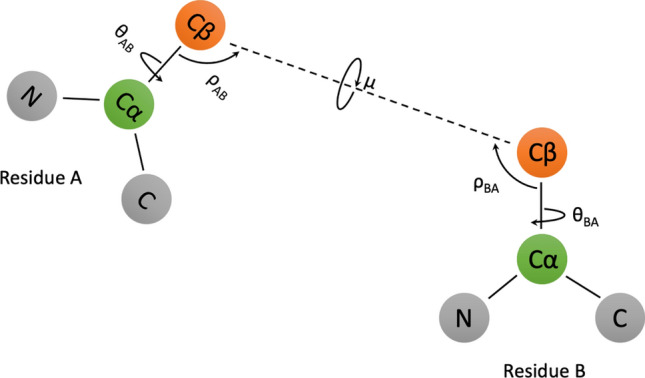
Orientation angles. The three orientation angles mu(μ), theta(θ) and rho(ρ) between any pair of residues in a protein. In the 3D structure of the protein, considering any two residues A and B, θAB represents the dihedral angle between the vectors NA—> CαA and CβA—> CβB along the axis of CαA—> CβA. ρAB represents the angle between the vectors CβA—> CαA and CβA—> CβB. θ and ρ depends on the order of residue and thus are asymmetric. μ represents the dihedral angle between the vectors CαA—> CβA and CβA—> CαB along the axis of CβA—> CβB. These orientation angles help in representing the direction of residue A to residue B and vice-versa. The orientation angles were originally described in Yang et al.23 We used different notations of angles from them to prevent confusion with conventionally used angle notation.
We used eight sequence-based input features. The 1D features are one hot encoding of amino acid type (20 features), PSI-BLAST28 position specific scoring matrix (20 features), HMM29 profile (30 features), SPOT-1D30 predicted secondary structure (3 features) and solvent accessible surface area (1 feature), making a total of 74 1D features. MSAs, from which the 1D features were computed, were generated using the DeepMSA15 pipeline. 1D features were converted into 2D features by combining features of two residues into one feature vector. We also used three 2D features, which were a predicted contact map by CCMPRED6 (1 feature), mutual information (1 feature), and statistical pairwise contact potential31 (1 feature). Thus, in total we used (2 × 74) + 3 = 151 L × L features, where L is the length of the protein.
The AttentiveDist network predicts the Cβ–Cβ distance of every pair of residues in a target protein as a vector of probabilities assigned to 20 distance bins. The first bin is for 0 to 4 Å, the next bins up to 8 Å are of a size 0.5 Å and then bins of a 1 Å size follow up to 18 Å. The last bin added is for no-contact, i.e. for 18 Å to an infinite distance. Similarly, the backbone φ, ψ angles were binned to 36 ranges, each of which has a 10-degree range. Three side-chain orientation angles, σ, θ, and μ (Fig. 2) were binned into 24, 24, and 15 bins, each with a size of 15 degrees, respectively. The side-chain orientation angles were only considered between residue pairs that are closer than 20 Å, and for the rest of the residue pairs a no contact bin was considered as the correct answer. For target values for training, the real distances and angles were converted into vectors where the bin containing the real distance/angle has value 1 and while the rest were set to 0.
The network was trained on a dataset of 11,181 non-redundant proteins, which were selected from the PISCES32 database. Sequences released after 1st May 2018 (i.e. the month of beginning of CASP13) were removed. Every pair has less than 25% sequence identity. Out of these, 1,000 proteins were selected randomly as the validation set, while the rest were used to train the models. More details are provided in the Method section.
Contact prediction performance
We compared the performance of AttentiveDist with several different input MSA settings on 43 FM (Free Modeling) and FM/TBM (Template-Based Modeling) domains from CASP13. FM and FM/TBM are harder targets compared to template-based modeling because they do not have any appropriate template protein available, necessitating de-novo prediction. We used the standard metric of top L/n predicted long range contacts precision and F1 score as used in other works, where L is length of the protein and n is 1, 2, and 5. Long range contacts are defined as contacts between residues that are 24 or more residues away. Since AttentiveDist predicts residue-residue distances instead of binary contact, we converted this to contact prediction by summing the probabilities of distance bins from minimum distance to 8 Å.
We performed an ablation study of our model to understand how much different additions contribute to the performance (Table 1). The baseline model shown at the top of the table is a single model that predicts only Cβ–Cβ distance using an E-value of 0.001 for feature generation. 0.001 was used for E-value because it gave the overall the highest precision among the other E-values used in AttentiveDist. Next, we added multitask learning, where the model predicts the distance, 2D side-chain orientation angles, and the backbone dihedral angles together, but without attention. The multi-task learning improved the L/1 precision from 0.451 to 0.468.
Table 1.
CASP13 FM and FM/TBM 43 targets long range precision and F1 score.
| Model | Precision | F1 score | ||||
|---|---|---|---|---|---|---|
| L/5 | L/2 | L/1 | L/5 | L/2 | L/1 | |
| Distance only (E: 10–3) | 0.700 | 0.586 | 0.451 | 0.224 | 0.359 | 0.411 |
| E-value 10–3 | 0.716 | 0.608 | 0.468 | 0.228 | 0.373 | 0.427 |
| E-value 10–1 | 0.693 | 0.587 | 0.452 | 0.216 | 0.363 | 0.415 |
| E-value 1 | 0.724 | 0.589 | 0.455 | 0.230 | 0.362 | 0.414 |
| E-value 10 | 0.696 | 0.580 | 0.452 | 0.217 | 0.354 | 0.411 |
| No-attention, 4 E-values | 0.705 | 0.602 | 0.472 | 0.223 | 0.371 | 0.432 |
| MSA selection | 0.713 | 0.604 | 0.472 | 0.226 | 0.373 | 0.433 |
| AttentiveDist (single) | 0.716 | 0.613 | 0.479 | 0.230 | 0.385 | 0.442 |
| 4 E-values (average) | 0.744 | 0.619 | 0.479 | 0.238 | 0.383 | 0.445 |
| AttentiveDist (Ensemble) | 0.746 | 0.624 | 0.493 | 0.241 | 0.387 | 0.454 |
| TripletRes | 0.701 | 0.587 | 0.451 | 0.230 | 0.363 | 0.415 |
| RaptorX-Contact | 0.744 | 0.612 | 0.481 | 0.248 | 0.381 | 0.441 |
L/5, L/2 and L/1 shows values when top L/5, L/2 or L/1 contact predictions with the highest probabilities were considered where L is the length of the protein. Values in bold are the highest in each column.
The next three rows compare multi-task learning results with four different E-values (0.001, 0.1, 1, and 10). The results show that on average an E-value of 0.001 performed the best. The sixth row, “No attention, 4 E-values” shows the results of using MSAs with the four E-values to compute four different 1D features but without the attention mechanism. In this model we concatenated the features of the 4 E-values and passed them to the network. This increased the L/1 precision to 0.472; however, the L/2 and L/5 decrease by 0.006 and 0.011, respectively. The reason of the decrease could be because the 4 MSAs were input in parallel without any weighting mechanism. We also compared with contact map probability based a MSA selection strategy23 where for each target one prediction out of the 4 MSAs was selected based on the sum of L/1 contact probability values. Interestingly, the MSA selection performance was similar to the “No attention, 4 E-values” strategy. The next strategy, the AttentiveDist (single) model, which used the attention mechanism, improved L/1 precision further to 0.479. We also computed the average probabilities from 4 single E-value models (4 E-value (average)), which yielded L/1 precision of 0.479. Finally, we averaged the outputs from the 5 models (4 single E-value models and the model with attention), the full AttentiveDist, which resulted in a 0.14 gain to achieve 0.493 in L/1 precision. We show the L/1 precision comparison of the 43 individual targets between No attention, 4 E-values and E-value 0.001 model in Fig. 3a. In Fig. 3b we compare the E-value 0.001 model and AttentiveDist and in Fig. 3c we compare No attention, 4 E-values and AttentiveDist. Overall, we show that using four different E-value MSA’s improves the performance in all L/1, L/2 and L/5 precision. A similar trend was observed when F1 score was considered, where AttentiveDist (single) improved the L/1 F1 score from 0.427 to 0.442 compared to the E-value 0.001 model.
Figure 3.
Individual target L/1 precision comparison between (a), 4 E-value model without attention and E-value 0.001 model (b) E-value 0.001 model and AttentiveDist c, 4 E-value model without attention and AttentiveDist. E-value 0.001 model represents the model trained with E-value 0.001 MSA features in multi-task fashion.
In Table 1 we also compare the performance with TripletRes13, the second best server method in CASP13, because it used the same MSA generation pipeline, DeepMSA, with the same sequence datasets. Comparison with the same MSAs makes the comparison more informative because the performance highly depends on the input MSA. There was a significant improvement in L/1 precision of 9.3% and F1 score of 9.4% when compared to TripletRes. When compared for individual targets (structure domains), AttentiveDist had a higher L/1 precision than TripletRes for 27 domains, tied for 2 domains out of the 43 domains (Fig. 4a). AttentiveDist had higher average precisions than RaptorX-Contact12, the top server methods in CASP13, as shown at the bottom of Table 1. RaptorX has a new development after CASP1433, but here we compared with their results in CASP13. Comparisons of individual targets (Fig. 4b) shows AttentiveDist showed a higher L/1 precision than Raptor-X for 23 domains and tied for 2 domains out of the 43 domains.
Figure 4.
Long L/1 precision comparison of the 43 CASP13 FM and FM/TBM domains between (a) TripletRes and AttentiveDist. AttentiveDist showed a higher L/1 precision than TripletRes for 27 domains and tied for 2 domains out of the 43 domains. (b) Raptor-X and AttentiveDist. AttentiveDist showed a higher L/1 precision than Raptor-X for 23 domains and tied for 2 domains out of the 43 domains.
Prediction performance relative to the size of MSAs
As observed by previous works12,13, we also observed correlation between the size of MSAs, i.e. the number of sequences in the MSAs and the contact prediction accuracy. In Fig. 5a, the L/1 long range contact precisions were shown for two methods, AttentiveDist and the model using only MSAs of E-value 0.001, relative to the number of sequences in the MSAs. The number of sequences in the MSAs is shown in the log scale. A positive correlation was observed, as shown in the figure, and particularly, there is clear distinction of the performance at the sequence count of 100. When the sequence count was less than 100, L/1 precision was always below 0.4. Oppositely, when the sequence count is very high, over 10,000, high precisions of over 0.75 were observed. Although the high precision was observed with a large number of sequences, observed precisions had a large range of values when the sequence counts was over 100.
Figure 5.
Analysis of the MSA size and the attention. (a) Relationship between log of the sequence counts in MSAs and long-range L/1 contact precision for the 43 CASP13 targets. AttentionDist (blue) and the E-value 0.001 model (red), where E-value 0.001 was used as a cutoff for generating MSAs. The lines represent the regression. (b) the fraction of residue pairs where the MSA with the highest attention agreed with the MSA with the highest mutual information (MI). The number of targets among the 35 CASP13 target proteins that have the particular fraction of agreed residue pairs were counted for each bin. 43 FM and FM/TBM CASP13 target domains belong to 35 proteins. Out of the 35 proteins, two proteins were discarded from this analysis because the four MSAs with different E-value cutoffs of these proteins were identical. (c) the agreement is compared with the contact probability computed from the four MSAs with CCMPred.
Analyses of attention weights
In AttentiveDist, for each residue pair, attention values are distributed across four MSA-based features each computed with the four different E-value cutoffs, which sum up to 1.0. To understand what the attention mechanism captures, in Fig. 5b,c we examined how the attention corresponds to co-evolution signals. We compared with local and global co-evolutionary signals. The local co-evolutionary signal used is mutual information (MI), which uses pairwise residue profile information. The global signal considers effects from other residues as well, which can be computed by pseudo-likelihood maximization (PLM). We used CCMPred6, which is an implementation of PLM. For each residue pair in a protein target, we counted the number of times the MSA with the highest attention weight assigned by AttentiveDist agrees with the MSA with the highest co-evolutionary signal. As reference, we computed random-level agreement, where the MSA assignment for each residue pair was shuffled while keeping the fraction of times that each MSA had the highest attention weight in the original computation the same. The average agreement for MI was 0.329 compared to a random agreement of 0.298, and for CCMPred it was 0.376 compared to 0.277 random agreement. In both cases the agreement was higher than random. The histogram shifted to higher values when compared with CCMPred than MI. The average agreement for the 33 proteins were higher for CCMPred than MI. Thus, overall, the attention is a mechanism to select MSAs with higher co-evolutionary signals.
We also analyzed attention weights assigned to each MSA features in targets. First, for each target, we summed attention values given to each MSA over all residue pairs in the target and selected the one with the highest sum as most informative. We found that out of 43 targets, in 32 targets E-value 0.001 received the most attention, while E-value 0.1, 1, and 10 received the most attention for 1, 1, and 8 targets, respectively.
Next, we analyzed attention values given to residue pairs in a target. Figure 6a–c, show the maximum, minimum, and standard deviation of attention weights given to four MSAs in each target. The average statistics for the CASP13 targets are shown in Table 2. We can observe that the attention weight values vary for different targets. Figure 6d shows the percentage of residue pairs that had the largest attention weight for each MSA feature. We can see that E-value 0.001 shared the largest fraction of residue pairs for most of the targets. This is understandable considering that E-value of 0.001 showed the highest prediction performance (Table 1) among the four MSA features.
Figure 6.
Statistics of pairwise attention weights given to the 43 CASP13 targets. (a) the maximum attention weight given to each MSA among values for all the residue pairs. (b) the minimum attention weight given to each MSA. c, standard deviation given to each MSA. (d) Percentage of residue pairs in a target where each MSA had the largest attention weight. In all figures the x-axis represents the 43 CASP13 targets. Four MSAs with E-value of 0.001, 0.1, 1, and 10 are shown in blue, red, green, and yellow lines.
Table 2.
Statistics of attention weights given to different E-value based features averaged over 43 CASP13 FM and FM/TBM domain targets.
| MSA E-value | Max | Min | Std |
|---|---|---|---|
| 0.001 | 0.486 | 0.129 | 0.030 |
| 0.1 | 0.397 | 0.141 | 0.022 |
| 1 | 0.382 | 0.138 | 0.021 |
| 10 | 0.424 | 0.124 | 0.027 |
Angle prediction
Accuracy of angle prediction are provided in Table 3. The results shows the fraction of times that an angle is predicted at the exact correct bin or at a bin off by 1 or 2 bins. Within 2 bins, about 70% of the angles are predicted correctly.
Table 3.
Accuracy of backbone phi-psi and orientation angles for the 43 CASP13 FM and FM/TBM domain targets.
| Angle | Bin Slack | ||
|---|---|---|---|
| 0 | 1 (± 10°) | 2 (± 20°) | |
| φ | 0.277 | 0.590 | 0.722 |
| ϕ | 0.242 | 0.548 | 0.700 |
| Angle | Bin Slack | ||
|---|---|---|---|
| 0 | 1 (± 15°) | 2 (± 30°) | |
| μ | 0.332 | 0.582 | 0.634 |
| θ | 0.377 | 0.656 | 0.703 |
| σ | 0.394 | 0.692 | 0.748 |
The bin size of torsional angles was set to 10° while the bin for the orientation angles was 15°. Bin slack of 0 represents that the predicted bin of the highest probability and the real bin were the same. Bin slack of 1(or 2) denotes that the predicted bin was 1(or 2) bin(s) away from the correct bin.
Protein structure modeling
Finally, we built the tertiary structure models of the CASP13 domains and compared with the top CASP13 server models. For the structure modeling, in addition to the predictions of Cβ-Cβ distance, main-chain φ, ψ angles, and the three, σ, θ, and μ, side-chain orientation angles, we tested the inclusion of two additional distance constraints, which were Side-chain CEnter (SCE)-SCE distances and peptide-bond nitrogen (N)-oxygen (O) atom distances. These distances help in proper secondary structure formation and side-chain packing. All the constraints were converted into a potential function by normalizing predicted probability values in bins by predicted reference probability values. The folding was performed using Rosetta24 by adding the predicted potentials into the Rosetta energy function. Out of a few thousand models generated, the best scoring model for each target are reported in this section. Details are provided in Methods.
We compare the average TM scores of the predicted structures with three top CASP13 servers in Fig. 7a. For AttentiveDist, we showed results by two versions, one with the predicted SCE-SCE distances and the backbone N–O distances, which is denoted as AttentiveDist (Full), and the one without these two distance constraints (AttentiveDist w/o SCE and N–O). AttentiveDist w/o SCE and N–O improved the TMscore from 0.552 to 0.568 compared to the single E-value 0.001 multi-task trained model, demonstrating the effectiveness of using four MSA’s in structure modeling. Comparing two versions of AttentiveDist, the two distance constraints further improved the TMscore by 2.1% from 0.568 to 0.579. In Fig. 8, TM-scores of individual domain targets by the two versions of AttentiveDist are shown. For 19 domains the multi-task AttentiveDist showed a higher GDT-TS and tied for 4 domains out of 43 domains in total.
Figure 7.
Performance in structure modelling. (a) TM-score for AttentiveDist, AttentiveDist without using predicted sidechain center distance and backbone N–O distance and the top 3 server methods in CASP13 for 43 FM and FM/TBM targets. (b) Individual target TM-score comparison between our method and the Zhang-Server. The registered name of Raptor-X in CASP13 was RaptorX-DeepModeller and BAKER-ROSETTASERVER for Rosetta Server.
Figure 8.
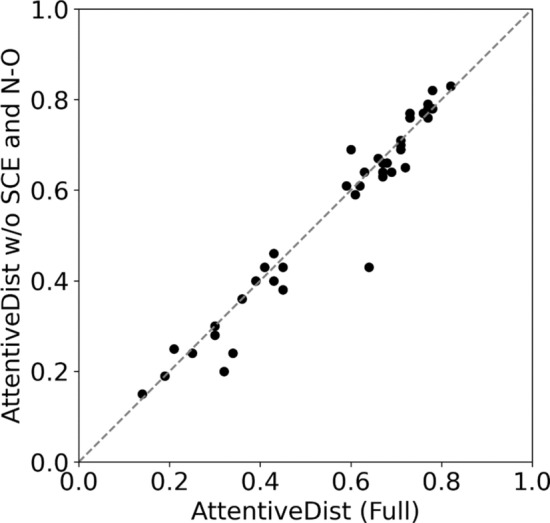
TM-score of AttentiveDist (Full) and AttentiveDist without using predicted SCE-SCE and N–O distances on the 43 CASP13 domains. AttentiveDist (Full) showed higher TM-Score for 19 targets, tied on 6 targets.
AttentiveDist showed higher average TM scores than the top-three CASP13 severs, Zhang-Server (0.517), RaptorX-DeepModeller (0.508), and BAKER-ROSETTASERVER (0.450), which are shown in Fig. 7a as well. As we used the same MSA extraction strategy as Zhang-Server, in Fig. 7b, we further show the TMscores of the 43 individual targets by AttentiveDist (Full) and Zhang-Server. AttentiveDist (Full) showed a higher TM-Score than Zhang-Server for 29 cases and tied for 3 cases. We also compared the residue-residue contact area difference (CAD) score34 in Table 4. CAD score determines the structure similarity by comparing the inter-atomic contact area between the reference and predicted structure. AttentiveDist improved both the AA (all residues) and SS (only sidechain residues) CAD score compared to the server models.
Table 4.
Average CAD score of top 1 predicted PDB for the 43 CASP13 FM and FM/TBM domain targets.
| Model | CAD | |
|---|---|---|
| AA | SS | |
| Zhang-Server | 0.512 | 0.237 |
| RaptorX-DeepModeller | 0.500 | 0.231 |
| BAKER-ROSETTASERVER | 0.509 | 0.225 |
| AttentiveDist (Full) | 0.545 | 0.283 |
In AA all residue atoms are taken into consideration, while in SS only sidechain atoms are taken into consideration.
Figure 9 provides four examples of models computed with distance prediction by AttentiveDist (Full) in comparison with Zhang-Server, RaptorX-DeepModeller, and BAKER-ROSETTASERVER. The first panel, Fig. 9a, is a 180-residue long domain with two α-helices and two β-sheets, T0957s1-D1. While our model has a TM-score of 0.78, indicating that the overall conformation is almost correct, the models by the other three methods have some substantial differences from the native. The Zhang-Server model missed one β-sheet, the RaptorX-DeepModeller did not predict any β-sheets, and the BAKER-ROSETTASERVER placed the β-sheet at the top of the structure and a α -helix in substantially different orientations.
Figure 9.
Examples of structure models by AttentiveDist (Full) in comparison with the top-1 model by the three top servers. AttentiveDist (Full), green; Zhang-Server, red; RaptorX-DeepModeller, orange; and BAKER-ROSETTASERVER, blue. The native structures are shown in gray. TM-scores, CAD AA, and CAD SS are shown in parentheses, respectively, separated by /. Targets are (a) T0957s1-D1 (PDB ID: 6cp8; length: 180 amino acids); (b) T0980s1-D1 (PDB ID: 6gnx; 104 aa); (c) T0986s2-D1 (PDB ID: 6d7y; 155 aa); (d) T0950-D1 (PDB ID: 6ek4; 331 aa).
The second example, T0980s1-D1 (Fig. 9b) is another αβ class protein with a long loop region, which is placed on the right-hand side of the figures. The loop is difficult to correctly model, as the three top CASP13 servers did not fold it well. The incorrect modeling of the loop also affected to the placement of the α-helix in the right orientation in their models. Our AttentiveDist model managed to have the overall fold almost correct, as shown by a higher TM-score of 0.64. For the next target, T0986s2-D1 (Fig. 9c), the Zhang-Server has almost all the architecture correct, but slight shifts of α helices cost it in the TM-score, which was 0.59. Our model had the conformation almost correct even in the loop regions, resulting in a high score of 0.78. The BAKER-ROSETTASERVER model did not assemble the large β-sheet correctly. The last target shown has an α-helical structure, which consists of two long α-helices with multiple small α-helices. (T0950-D1, Fig. 9d). While our model identified correct orientations for the two long helices, the other methods built them incorrectly which caused other incorrect helix arrangements at the top of the structure in the figure, resulting in lower scores.
Discussion
We presented AttentiveDist, a deep learning-based method for predicting residue distances and angles from four MSAs with four different E-value cutoffs. By adding an attention layer to the network, useful features from MSAs were selectively extracted, which led to higher predictive performance. In AttentiveDist, the attention layer as well as multi-tasking strategy boosted the prediction accuracy. In the context of the recent intensive efforts for developing residue distance/contact prediction methods by the community, this work shows another strong demonstration of how protein structure information can be further squeezed by exploiting modern deep learning technologies. Although our approach showed higher precision for free modelling targets, an improvement is still needed especially when the available sequences are sparse for input MSAs, which remains as an important future work.
Methods
Training, validation, and test datasets
For the training and validation dataset, we took proteins from the PISCES32 database that consists of a subset of proteins having less than 25% sequence identity and a minimum resolution of 2.5 angstroms, released in October 2019. We further pruned this dataset by removing proteins that contain more than 600 or less than 50 amino acids and those released after 1st May 2018 (i.e. the month of beginning of CASP13). Next, proteins that have intermediate gaps of more than 50 residues, not considering the termini, were removed. Finally, a protein that has 2-letter chain names was removed because PISCES capitalizes chain names making it confusing for cases where the real 2 letter chain name has both mixed lowercase and uppercase alphabets used. This resulted in 11,181 proteins. Out of those, 1,000 proteins were selected randomly as the validation set, and the rest were used to train the models. For each instance of glycine, a pseudo-Cβ atom was built to be able to define Cβ-Cβ distance by converting it to alanine.
CASP13 FM and FM/TBM domains were used as the test set, containing 43 domains (across 35 proteins). The full protein sequence was used in the input instead of the domain to replicate the CASP13 competition.
MSA generation
To generate the MSA we used the DeepMSA15 pipeline. This pipeline consists of three stages where three different databases are searched to obtain similar sequences, which produces better MSAs compared to a single database search. The packages used for DeepMSA were HHsuite35 version 3.2.0 and HMMER36 version 3.3. The sequence databases we used were released before the CASP13 competition began for the sake of fair comparison, and were: Uniclust3037 database dated October 2017, Uniref9038 dated April 2018, and Metaclust_NR39 database dated January 2018. We generated 4 different MSAs with E-value 0.001, 0.1, 1, and 10 used in HHsuite35 and HMMER21,36.
Network parameters and training
In AttentiveDist the convolution filter (kernel) size is 5 × 5 for the first 3 blocks and then 3 × 3 for the rest of the network, and the channels were kept constant to 64. We also added dilation to increase the receptive field of the network, with dilation cycling through 1,2 and 4.
The loss function used during training is the weighted combination of individual objective loss. For each objective cross-entropy loss was used and the weights were manually tuned. Distance and orientation angles losses were given weight of 1 while the backbone φ and ψ angle losses were given weight of 0.05 each. The Adam40 optimizer with a learning rate of 0.0001 was used. Dropout probability was 0.1. Dilations were cycled between 1, 2 and 4. The learning rate, dropout and loss weights were tuned on the validation dataset. We trained the model for 80 epochs. Batch size was set to 1 because of GPU memory constraints.
Sidechain center distance and backbone hydrogen-bond (N–O) prediction
For the tertiary structure modeling, we tested the inclusion of two additional predicted distance constraints, distances between Side-Chain cEnters (SCE) and distances between the nitrogen and the oxygen (N–O) in peptide bonds. These distances were binned similarly to the Cβ–Cβ distances. The first bin was for a distance between 0 to 2 Å, bins up to 20 Å were of a width of 0.5 Å, followed by a bin of size 20 Å to infinite. A bin for residue pairs with missing information was also added. For prediction, we used networks with 25 ResNet blocks, which is smaller than the one in Fig. 1. The model was trained on the E-value 0.001 MSA data (Fig. 10). The prediction performance for SCE distances and N–O distances are is shown in Table 5.
Figure 10.
ResNet model architecture for (a) Sidechain Center (SCE) distances and (b) backbone peptide N–O pairwise distance prediction. The ResNet Block is the same as described in Fig. 1b. conv2d (green) is 2d convolution layer, INorm (blue) is instance normalization, ELU (orange) is Exponential Linear Unit.
Table 5.
Long range precision of prediction made for Side-Chain cEnters (SCE) contact and contact between the nitrogen and the oxygen (N–O) in peptide bonds.
| Prediction | L/5 | L/2 | L/1 |
|---|---|---|---|
| SCE | 0.688 | 0.530 | 0.410 |
| N–O | 0.856 | 0.744 | 0.545 |
The contact is defined if as pairs within 8 Å for SCE-SCE, and 4 Å for N–O. The 43 CASP13 FM and FM/TBM targets were considered.
Protein 3D structure generation from distance prediction
We performed protein structure modeling similar to the work by Yang et al.23 We used Rosetta’s protein folding and energy minimization protocols with customized constraints. The constraints were computed from our predictions of distance distributions (Cβ-Cβ, SCE-SCE, and backbone N–O) and angle distributions (backbone φ–ψ and the three residue-pair orientation angles) by normalizing the predicted values with predicted reference distributions. For both distance and angle constraints, the predicted distributions were converted to an energy potential as follows:
| 3 |
where Pi and REFi are the predicted probability and the reference probability of i-th bin, respectively. N is the number of bins in the predicted distribution.
The reference probability distributions of three distances, backbone angles, and the side-chain orientation angles were predicted with a five-layer fully-connected neural networks. A network of the same architecture was trained for each type of constraints. For a distance type, the features used were the positions i and j of the two amino acids, the length of the protein, and a binary feature of whether a residue is glycine or not11. For angle predict we also included the one-hot encoding of the amino acid type.
All energy potentials were smoothed by the spline function in Rosetta, and then used as constraints in the energy minimization protocol. The energy potentials of distances (Cβ-Cβ, SCE-SCE and backbone N–O) and inter-residue orientations were split into L/10*L/10 blocks. To explore a diverse conformational space, the blocks of the potentials were randomly added to the energy function in the minimization steps. We generated 4,000 decoy models with different folding paths (i.e. additions of the blocks of potentials) and weight parameters that balance the energy terms. All decoy models were ranked by ranksum41, a sum of the ranks of three scoring functions, GOAP42, DFire43, and ITScore44. The best scoring model was selected as the predicted structure.
Acknowledgements
We thank Xiao Wang for checking and test running the codes. This work was partly supported by the National Institutes of Health (R01GM123055, R01GM133840) and the National Science Foundation (DMS1614777, CMMI1825941, MCB1925643, DBI2003635).
Author contributions
D.K. conceived the study. A.J. developed the algorithm and wrote the codes. A.J., Y.K. and S.R.M.V.S. generated MSAs. G.T. generated protein structures models. C.C. computed score ranking of generated protein structure models. A.J., G.T., and D.K. analyzed the results. A.J. drafted and D.K. edited and finalized the manuscript. All the authors reviewed the manuscript.
Code availability
Code is made available at http://github.com/kiharalab/AttentiveDist.
Competing interests
The authors declare no competing interests.
Footnotes
Publisher's note
Springer Nature remains neutral with regard to jurisdictional claims in published maps and institutional affiliations.
References
- 1.Kuhlman B, Bradley P. Advances in protein structure prediction and design. Nat. Rev. Mol. Cell Biol. 2019;20:681–697. doi: 10.1038/s41580-019-0163-x. [DOI] [PMC free article] [PubMed] [Google Scholar]
- 2.Shin WH, Christoffer CW, Wang J, Kihara D. PL-patchsurfer2: improved local surface matching-based virtual screening method that is tolerant to target and ligand structure variation. J. Chem. Inf. Model. 2016;56:1676–1691. doi: 10.1021/acs.jcim.6b00163. [DOI] [PMC free article] [PubMed] [Google Scholar]
- 3.Abriata LA, Tamò GE, Dal Peraro M. A further leap of improvement in tertiary structure prediction in CASP13 prompts new routes for future assessments. Proteins Struct. Funct. Bioinform. 2019;87:1100–1112. doi: 10.1002/prot.25787. [DOI] [PubMed] [Google Scholar]
- 4.Adhikari B, Cheng J. CONFOLD2: improved contact-driven ab initio protein structure modeling. BMC Bioinform. 2018;19:22. doi: 10.1186/s12859-018-2032-6. [DOI] [PMC free article] [PubMed] [Google Scholar]
- 5.Morcos F, et al. Direct-coupling analysis of residue coevolution captures native contacts across many protein families. Proc. Natl. Acad. Sci. USA. 2011;108:E1293–1301. doi: 10.1073/pnas.1111471108. [DOI] [PMC free article] [PubMed] [Google Scholar]
- 6.Seemayer S, Gruber M, Soding J. CCMpred–fast and precise prediction of protein residue-residue contacts from correlated mutations. Bioinformatics. 2014;30:3128–3130. doi: 10.1093/bioinformatics/btu500. [DOI] [PMC free article] [PubMed] [Google Scholar]
- 7.Jones DT, Buchan DW, Cozzetto D, Pontil M. PSICOV: precise structural contact prediction using sparse inverse covariance estimation on large multiple sequence alignments. Bioinformatics. 2012;28:184–190. doi: 10.1093/bioinformatics/btr638. [DOI] [PubMed] [Google Scholar]
- 8.Ovchinnikov S, Kamisetty H, Baker D. Robust and accurate prediction of residue-residue interactions across protein interfaces using evolutionary information. Elife. 2014;3:e02030. doi: 10.7554/eLife.02030. [DOI] [PMC free article] [PubMed] [Google Scholar]
- 9.Marks DS, et al. Protein 3D structure computed from evolutionary sequence variation. PLoS ONE. 2011;6:e28766. doi: 10.1371/journal.pone.0028766. [DOI] [PMC free article] [PubMed] [Google Scholar]
- 10.Ekeberg M, Lovkvist C, Lan Y, Weigt M, Aurell E. Improved contact prediction in proteins: using pseudolikelihoods to infer Potts models. Phys. Rev. E Stat. Nonlinear Soft Matter Phys. 2013;87:012707. doi: 10.1103/PhysRevE.87.012707. [DOI] [PubMed] [Google Scholar]
- 11.Senior AW, et al. Improved protein structure prediction using potentials from deep learning. Nature. 2020;577:706–710. doi: 10.1038/s41586-019-1923-7. [DOI] [PubMed] [Google Scholar]
- 12.Xu J, Wang S. Analysis of distance-based protein structure prediction by deep learning in CASP13. Proteins. 2019;87:1069–1081. doi: 10.1002/prot.25810. [DOI] [PubMed] [Google Scholar]
- 13.Li Y, Zhang C, Bell EW, Yu DJ, Zhang Y. Ensembling multiple raw coevolutionary features with deep residual neural networks for contact-map prediction in CASP13. Proteins. 2019;87:1082–1091. doi: 10.1002/prot.25798. [DOI] [PMC free article] [PubMed] [Google Scholar]
- 14.Hanson J, Paliwal K, Litfin T, Yang Y, Zhou Y. Accurate prediction of protein contact maps by coupling residual two-dimensional bidirectional long short-term memory with convolutional neural networks. Bioinformatics. 2018;34:4039–4045. doi: 10.1093/bioinformatics/bty481. [DOI] [PubMed] [Google Scholar]
- 15.Zhang C, Zheng W, Mortuza SM, Li Y, Zhang Y. DeepMSA: constructing deep multiple sequence alignment to improve contact prediction and fold-recognition for distant-homology proteins. Bioinformatics. 2020;36:2105–2112. doi: 10.1093/bioinformatics/btz863. [DOI] [PMC free article] [PubMed] [Google Scholar]
- 16.Xu J. Distance-based protein folding powered by deep learning. Proc. Natl. Acad. Sci. USA. 2019;116:16856–16865. doi: 10.1073/pnas.1821309116. [DOI] [PMC free article] [PubMed] [Google Scholar]
- 17.Addou S, Rentzsch R, Lee D, Orengo CA. Domain-based and family-specific sequence identity thresholds increase the levels of reliable protein function transfer. J. Mol. Biol. 2009;387:416–430. doi: 10.1016/j.jmb.2008.12.045. [DOI] [PubMed] [Google Scholar]
- 18.Tian W, Skolnick J. How well is enzyme function conserved as a function of pairwise sequence identity? J. Mol. Biol. 2003;333:863–882. doi: 10.1016/j.jmb.2003.08.057. [DOI] [PubMed] [Google Scholar]
- 19.Luong, M.-T., Pham, H. & Manning, C. D. Effective approaches to attention-based neural machine translation. https://arxiv.org/abs/1508.04025 (2015).
- 20.Vaswani, A. et al. Attention is all you need. Advances in neural information processing systems, 5998–6008 (2017).
- 21.Xu, K. et al. Show, attend and tell: Neural image caption generation with visual attention. International conference on machine learning, 2048–2057 (2015).
- 22.Ramachandran, P. et al. Stand-alone self-attention in vision models. https://arxiv.org/abs/1906.05909 (2019).
- 23.Yang J, et al. Improved protein structure prediction using predicted interresidue orientations. Proc. Natl. Acad. Sci. USA. 2020;117:1496–1503. doi: 10.1073/pnas.1914677117. [DOI] [PMC free article] [PubMed] [Google Scholar]
- 24.Chaudhury S, Lyskov S, Gray JJ. PyRosetta: a script-based interface for implementing molecular modeling algorithms using Rosetta. Bioinformatics. 2010;26:689–691. doi: 10.1093/bioinformatics/btq007. [DOI] [PMC free article] [PubMed] [Google Scholar]
- 25.He, K., Zhang, X., Ren, S. & Sun, J. Deep residual learning for image recognition. In Proceedings of the IEEE Conference on Computer Vision and Pattern Recognition, 770–778 (2016).
- 26.Ulyanov, D., Vedaldi, A. & Lempitsky, V. Instance normalization: The missing ingredient for fast stylization. https://arxiv.org/abs/1607.08022 (2016).
- 27.Shah, A., Kadam, E., Shah, H., Shinde, S. & Shingade, S. Deep residual networks with exponential linear unit. In Proceedings of the Third International Symposium on Computer Vision and the Internet, 59–65 (2016).
- 28.Altschul SF, et al. Gapped BLAST and PSI-BLAST: A new generation of protein database search programs. Nucl. Acids Res. 1997;25:3389–3402. doi: 10.1093/nar/25.17.3389. [DOI] [PMC free article] [PubMed] [Google Scholar]
- 29.Remmert M, Biegert A, Hauser A, Söding J. HHblits: Lightning-fast iterative protein sequence searching by HMM-HMM alignment. Nat. Methods. 2012;9:173–175. doi: 10.1038/nmeth.1818. [DOI] [PubMed] [Google Scholar]
- 30.Hanson J, Paliwal K, Litfin T, Yang Y, Zhou Y. Improving prediction of protein secondary structure, backbone angles, solvent accessibility and contact numbers by using predicted contact maps and an ensemble of recurrent and residual convolutional neural networks. Bioinformatics. 2019;35:2403–2410. doi: 10.1093/bioinformatics/bty1006. [DOI] [PubMed] [Google Scholar]
- 31.Betancourt MR, Thirumalai D. Pair potentials for protein folding: choice of reference states and sensitivity of predicted native states to variations in the interaction schemes. Protein Sci. 1999;8:361–369. doi: 10.1110/ps.8.2.361. [DOI] [PMC free article] [PubMed] [Google Scholar]
- 32.Wang G, Dunbrack RL., Jr PISCES: Recent improvements to a PDB sequence culling server. Nucl. Acids Res. 2005;33:W94–98. doi: 10.1093/nar/gki402. [DOI] [PMC free article] [PubMed] [Google Scholar]
- 33.Xu, J., Mcpartlon, M. & Li, J. Improved protein structure prediction by deep learning irrespective of co-evolution information. bioRxiv (2020). [DOI] [PMC free article] [PubMed]
- 34.Olechnovič K, Kulberkytė E, Venclovas Č. CAD-score: A new contact area difference-based function for evaluation of protein structural models. Proteins Struct. Funct. Bioinform. 2013;81:149–162. doi: 10.1002/prot.24172. [DOI] [PubMed] [Google Scholar]
- 35.Steinegger M, et al. HH-suite3 for fast remote homology detection and deep protein annotation. BMC Bioinform. 2019;20:473. doi: 10.1186/s12859-019-3019-7. [DOI] [PMC free article] [PubMed] [Google Scholar]
- 36.Potter SC, et al. HMMER web server: 2018 update. Nucl. Acids Res. 2018;46:W200–W204. doi: 10.1093/nar/gky448. [DOI] [PMC free article] [PubMed] [Google Scholar]
- 37.Mirdita M, et al. Uniclust databases of clustered and deeply annotated protein sequences and alignments. Nucl. Acids Res. 2017;45:D170–D176. doi: 10.1093/nar/gkw1081. [DOI] [PMC free article] [PubMed] [Google Scholar]
- 38.Suzek BE, et al. UniRef clusters: a comprehensive and scalable alternative for improving sequence similarity searches. Bioinformatics. 2015;31:926–932. doi: 10.1093/bioinformatics/btu739. [DOI] [PMC free article] [PubMed] [Google Scholar]
- 39.Steinegger M, Söding J. Clustering huge protein sequence sets in linear time. Nat. Commun. 2018;9:1–8. doi: 10.1038/s41467-018-04964-5. [DOI] [PMC free article] [PubMed] [Google Scholar]
- 40.Loshchilov, I. & Hutter, F. Decoupled weight decay regularization. https://arxiv.org/abs/1711.05101 (2017).
- 41.Christoffer C, et al. Performance and enhancement of the LZerD protein assembly pipeline in CAPRI 38–46. Proteins. 2020;88:948–961. doi: 10.1002/prot.25850. [DOI] [PMC free article] [PubMed] [Google Scholar]
- 42.Zhou H, Skolnick J. GOAP: a generalized orientation-dependent, all-atom statistical potential for protein structure prediction. Biophys. J. 2011;101:2043–2052. doi: 10.1016/j.bpj.2011.09.012. [DOI] [PMC free article] [PubMed] [Google Scholar]
- 43.Zhou H, Zhou Y. Distance-scaled, finite ideal-gas reference state improves structure-derived potentials of mean force for structure selection and stability prediction. Protein Sci. 2002;11:2714–2726. doi: 10.1110/ps.0217002. [DOI] [PMC free article] [PubMed] [Google Scholar]
- 44.Huang SY, Zou X. An iterative knowledge-based scoring function to predict protein–ligand interactions: II. Validation of the scoring function. J. Comput. Chem. 2006;27:1876–1882. doi: 10.1002/jcc.20505. [DOI] [PubMed] [Google Scholar]
Associated Data
This section collects any data citations, data availability statements, or supplementary materials included in this article.
Data Availability Statement
Code is made available at http://github.com/kiharalab/AttentiveDist.



